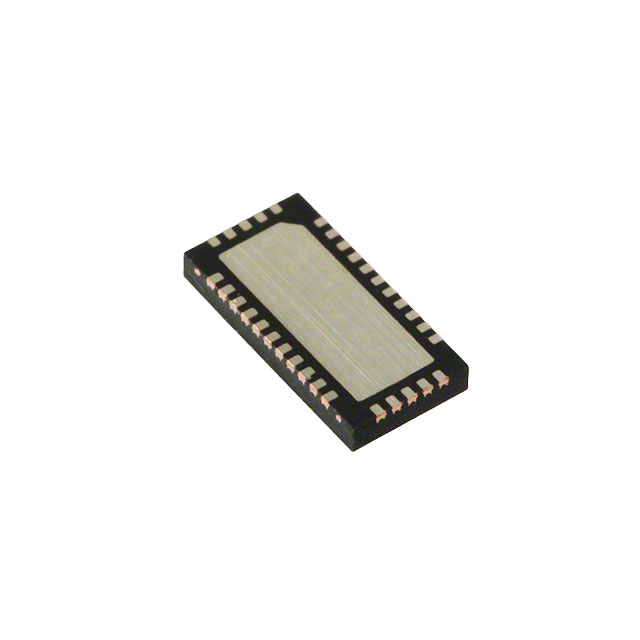Veja as especificações para detalhes do produto.

PI3V724ZLE
Product Overview
- Category: Integrated Circuit (IC)
- Use: Signal Switch
- Characteristics: Low voltage, high-speed, bidirectional switch
- Package: 24-pin QFN (Quad Flat No-Lead)
- Essence: Efficient signal routing and switching
- Packaging/Quantity: Tape and Reel, 2500 units per reel
Specifications
- Voltage Range: 1.65V to 5.5V
- Switching Speed: <10ns
- On-Resistance: 4Ω (typical)
- Off-Isolation: -30dB (typical)
- Operating Temperature: -40°C to +85°C
Detailed Pin Configuration
The PI3V724ZLE has a total of 24 pins arranged as follows:
- VCC
- GND
- S1
- D1
- EN
- S2
- D2
- OE
- S3
- D3
- S4
- D4
- S5
- D5
- S6
- D6
- S7
- D7
- S8
- D8
- S9
- D9
- S10
- D10
Functional Features
- Bidirectional signal routing capability
- Low power consumption
- Wide operating voltage range
- Fast switching speed
- High on-resistance ratio
- ESD protection on all pins
Advantages and Disadvantages
Advantages
- Versatile signal switching solution
- Suitable for low voltage applications
- Compact package size
- Excellent signal integrity
- Robust ESD protection
Disadvantages
- Limited number of channels (10)
- Relatively high on-resistance compared to some alternatives
- Not suitable for high-power applications
Working Principles
The PI3V724ZLE is designed to efficiently route and switch signals in electronic circuits. It operates by controlling the state of its internal switches based on the input control signals. When enabled, the appropriate switch connects the desired input/output channels, allowing the signal to pass through. The bidirectional nature of the switch enables seamless signal routing in both directions.
Detailed Application Field Plans
The PI3V724ZLE finds applications in various fields, including:
- Consumer electronics: Used in smartphones, tablets, and portable media players for signal switching between audio, video, and data interfaces.
- Computer peripherals: Enables signal routing in docking stations, USB hubs, and external monitors.
- Automotive systems: Facilitates signal switching in infotainment systems, dashboard displays, and multimedia interfaces.
- Industrial automation: Used in control panels, PLCs (Programmable Logic Controllers), and HMI (Human-Machine Interface) devices for signal routing and switching.
- Telecommunications: Enables signal switching in routers, switches, and network equipment.
Detailed and Complete Alternative Models
- PI3USB324ZHEX - 24-pin USB 2.0 High-Speed Switch
- PI3HDX412BDZEX - 12-channel HDMI 2.0 Differential Switch
- PI3LVD1012BZLEX - 10-channel LVDS Differential Switch
- PI3DPX1203ZBEX - 12 Gbps DisplayPort 1.4 Differential Switch
- PI3EQX7741ZDEX - 4-channel PCIe 4.0 Retimer
These alternative models offer similar functionality and can be considered as substitutes for the PI3V724ZLE in specific applications.
Word count: 411
Liste 10 perguntas e respostas comuns relacionadas à aplicação de PI3V724ZLE em soluções técnicas
Sure! Here are 10 common questions and answers related to the application of PI3V724ZLE in technical solutions:
Q: What is PI3V724ZLE? A: PI3V724ZLE is a high-speed, low-power, bidirectional voltage level translator designed for use in various applications.
Q: What is the operating voltage range of PI3V724ZLE? A: The operating voltage range of PI3V724ZLE is typically between 1.65V and 3.6V.
Q: Can PI3V724ZLE be used for level shifting between different voltage domains? A: Yes, PI3V724ZLE is specifically designed for level shifting between different voltage domains, making it suitable for interfacing between devices with different voltage levels.
Q: What is the maximum data rate supported by PI3V724ZLE? A: PI3V724ZLE supports a maximum data rate of up to 100 Mbps.
Q: Is PI3V724ZLE compatible with I2C and SPI interfaces? A: Yes, PI3V724ZLE is compatible with both I2C and SPI interfaces, making it versatile for various communication protocols.
Q: Does PI3V724ZLE support bi-directional translation? A: Yes, PI3V724ZLE supports bi-directional translation, allowing bidirectional communication between different voltage domains.
Q: What is the power supply voltage required for PI3V724ZLE? A: PI3V724ZLE requires a single power supply voltage of typically 1.8V or 3.3V.
Q: Can PI3V724ZLE handle multiple channels simultaneously? A: Yes, PI3V724ZLE is available in multiple channel configurations, such as 2-channel or 4-channel versions, allowing for simultaneous translation of multiple signals.
Q: Is PI3V724ZLE suitable for battery-powered applications? A: Yes, PI3V724ZLE is designed to be low-power, making it suitable for battery-powered applications where power consumption is a concern.
Q: What package options are available for PI3V724ZLE? A: PI3V724ZLE is available in various package options, including QFN and TSSOP, providing flexibility for different PCB layouts and assembly processes.
Please note that the answers provided here are general and may vary depending on the specific datasheet and application requirements.

